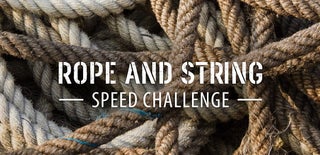Introduction: Transform Retired Climbing Rope Into Bowls and Other Useful Things
Rope bowls are quite popular and understandably so with their colorful patterns, intricate texture, and soft feel. They are a fun way to breathe new life into an old retired piece of rope or to transform a new piece of rope into something unique. While I will mention multiple materials and techniques in this Instructable, the primary material and technique I will be describing is using retired rock climbing rope and a zig-zag stitch on a motorized sewing machine.
Step 1: Materials and Techniques
Materials used for rope bowls vary widely from small soft cotton cord to large stiff twisted and braided ropes. There are many great Instructables and YouTube videos covering the many different methods of construction, from liquid adhesives to weaving to hand lacing and industrial sewing. The method described in the following steps can be used for a variety of materials but here only depicts the use of retired rock climbing rope.
Step 2: Does It Fit?
Many household sewing machines can fit small cord and small rope (6mm diameter or smaller) between the presser foot and throat plate and sew through it with relative ease. This is what many of the videos you will find nowadays on YouTube depict. Larger ropes however present an immediate challenge of simply fitting into the machine. Now I'm sure that there are more industrial machines that can accommodate climbing ropes without modification, but being that I do not have one of those, I decided to tweak to my home/hobbiest machine to make it work. Part of this was accomplished by adjusting the presser foot linkage via a set screw, and partly by modifying the presser foot itself. There is obviously a limit to how far you can go and every machine will vary, but I was able to get about 10mm total clearance on my Singer (vs the ~6 mm I started with).
Step 3: Start the Coil
Once you can fit the rope under your machine, get some good strong nylon or other thread and dial up your tension until you can sew a nice zig zag pattern between two parallel strands. Climbing rope is rather stiff when compared to cotton cord, so the center of the spiral (bottom of the bowl) will have a hole in it if you do not trim back the core of the rope. Cutting the core on a diagonal helps taper and smoothly transition from full rope to a point.
Step 4: Round and Round We Go
Once you get the spiral going, it's actually quite fast to start building the base. A well placed fence helps with speed. As you can see a piece of packing tape and a found object can do the trick quite nicely
Step 5: Finishing It Off
Once you get to the end, whether you're making a drink coaster or a bowl, you can make a smooth termination by pulling out some core and doing another tapered cut similar to how you started. Alternatively, there are limitless options for handles or decorative finishes.
Step 6: Shapes of Bowls
The geometry of the sewing machine you are using may restrict the freedom you have to make any shape bowl you might want. Here you can see that a larger machine (forehead?) will limit your ability to make fast 90º bends from the base of your bowl to the sides. If you want to make a coaster, dish, or shallow angle bowl, most machines will likely accommodate this. If you are like me and want to figure out a way to make a cylindrical shape bowl, go to the next step to see some potential options for modifying your machine
Step 7: More Machine Mods
I wanted to give my machine a face-lift so I removed the fixed light, added a flex light, chopped off the plastic top piece and made a new cover for the left side of the machine (head?) While I was at it I decided to give the yellowed plastic top a coat of matte black paint and oil it up before putting it back together. For me the inside of a sewing machine was a bit intimidating at first, but at least the older mechanical ones are pretty simple once you dive in. Just take pictures before so you know how to put everything back together.
Step 8: Squares and Other Stuff
Squares are possible, but rounds and ovals are certainly faster and easier. My girlfriend wanted to make a carry strap for her yoga mat, so we made a simple choker strap out of a pice of climbing rope and a couple sections of zig-zag stitches.
Thats all I have for now. I'm looking forward to trying out some more interesting shapes and I hope you too decide to give this a try. Please share if you decide to make something as a result of seeing this, I love seeing what others can come up with. Thanks for reading through to the end and happy making!

First Prize in the
Rope & String Speed Challenge











